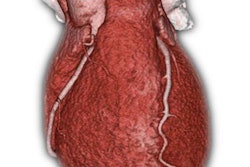Data on 7,557 screening subjects came from Europe's largest low-dose CT lung cancer screening study, the Dutch-Belgian Longkanker Screenings Onderzoek (NELSON) trial, and focused on solid nodules detected in incidence screening rounds subsequent to baseline screening.
After baseline screening with low-dose CT, incidence screenings were conducted at one, three, and five and a half years. About 11% of screening subjects developed nodules, with a little over half proving malignant.
"The results suggest that new solid nodules have a higher probability of being lung cancer than do baseline nodules, even at a smaller size," wrote presenter Joan Walter in an email to AuntMinnie.com.
Beyond that, nodule volume remained the most important predictor even after correction for potential confounding variables. Adding multiple risk factors to nodule volume didn't improve the team's ability to predict malignancy. But the importance of growth rate in nodule volume may require adjustment in nodule size thresholds for lesions detected after baseline.



















